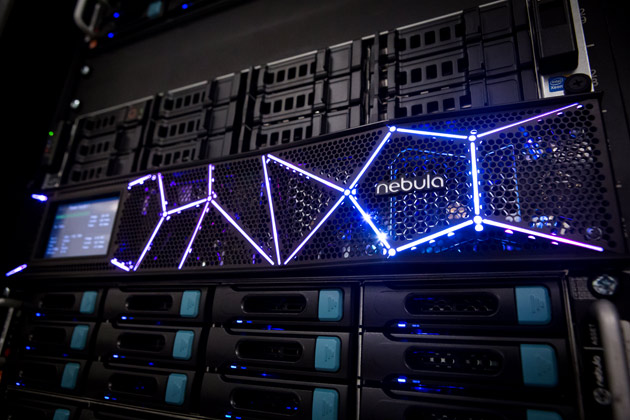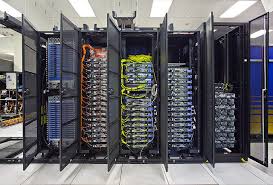Ashlee Vance| Businessweek
For his sixth-grade science fair project, Chris Kemp put together a cold fusion kit. In seventh grade, he built a particle accelerator using a 300,000-volt generator and a vacuum tube. His teachers thought his dad had helped; neither project won first place. “I pretty much wrote off science at that point,” says the 35-year-old Kemp, who eventually returned to it with a focus on computers.
While his latest project still may not win any grade-school science fair prizes, it’ll likely change the nature of cloud-computing.
Kemp has built a device called the Nebula One, a computer that functions as a command-and-control system for dozens of traditional servers, essentially tethering them together and consolidating their power into one machine. By plugging servers made by Dell or Hewlett-Packard or IBM into the Nebula One, a single person, as opposed to dozens, can control them simply by clicking a mouse around a software console. For about $100,000, any company can buy a Nebula One and have the same cutting-edge cloud computing power as Amazon.com, Google, or Microsoft.
Though it doesn’t look like much, (about the size of a four-inch tall pizza box) Nebula One is the product of dozens of engineers working in Mountain View Calif. for two years in secrecy. It’s attracted the attention of some of Silicon Valley’s top investors. The three billionaires who made the first investment in Google – Andy Bechtolsheim, David Cheriton and Ram Shriram – joined forces again to back Nebula One, betting that its technology will usher in a dramatic shift in corporate computing that outflanks the titans of the industry. “This is an example of where traditional technology companies have failed the market,” says Bechtolsheim, a co-founder of Sun Microsystems and famed hardware engineer. Kleiner Perkins Caufield & Byers, Comcast Ventures, and Highland Capital Partners have also backed Kemp’s startup, itself called Nebula, which has raised more than $30 million.
The origins of Nebula One go back to Kemp’s days at NASA, which he joined in 2006 as director of strategic business development. In 2007, he became a chief information officer, making him, at 29, the youngest senior executive in the U.S. government. In 2010, he became NASA’s chief technology officer. Kemp spent much his time at NASA developing more efficient data centers for the agency’s various computing efforts. He and a team of engineers built the early parts of what is now known as OpenStack, software that makes it possible to control an entire datacenter as one computer.
To see if other companies could take the idea further, Kemp made the software open-source. Big players like AT&T, Hewlett-Packard, IBM and Rackspace have since incorporated OpenStack into the cloud computing services they sell customers.
Kemp had another idea: he wanted to use OpenStack as a way to give every company its own private cloud, rather than paying big computing firms a hefty fee to use their servers. After hearing this idea during a meeting in 2011, Bechtolsheim, as he did with Google back in 1998, tried to cut Kemp a check on the spot. Kemp turned down the offer because he was a federal employee. A few months later, he re-considered. “I talked to my wife and some other people and the consensus was that this was a once in a lifetime opportunity,” Kemp says.
He founded Nebula, and hired some of the engineers he worked with at NASA, along with other leading contributors to OpenStack. They’ve spent the last two years working on Nebula One, which can also run software packages designed for Amazon.com’s cloud. Early versions have made it to a handful of clients.
Palo Alto Research Center, or PARC, has three Nebula One’s, which it uses for research projects such as one effort to improve parking in big cities. Researchers at PARC have been analyzing huge amounts of data to create models that show when workers, delivery vehicles, and shoppers tend to use certain parking spots. The idea is to create parking spots with modifiable, electronic signs that can turn, say, loading zones into regular parking spots over the course of a day. “You need to spin up a large simulation, get the results, present them and then sit back for a while,” says Roger Hoover, an engineer at PARC. With the Nebula One, an engineer can shut down one simulation and then start up a new project in a few seconds. Similar things are possible on Amazon.com’s EC2 service or Microsoft’s Azure, but those services can be expensive and slow when you’re dealing with sending large amounts of data back and forth via the Internet. “What we do just will not work on Amazon,” says Surendra Reddy, who leads the cloud technology work at PARC.
The entire computing industry has basically spent the last year developing technology needed to make managing a data center as a complete whole easier. Companies like Amazon, Google and Microsoft have their own custom versions of this type of software, and OpenStack represents a populist version of similar code.
Nebula One was designed to run OpenStack smoothly and update it automatically, so that mainstream companies don’t need to hire a team of engineers to figure out how the software works. “Our system operates in a sense like a laptop because you can turn it on with the push of a button,” Kemp says. “But we make it possible to share petabytes of storage and thousands of processor cores among thousands of people.”
Nebula has plenty of competition. Amazon, Microsoft and Google offer competing services. VMware, one of the dominant players in data centers, also has a suite of software it uses to meld lots of computers into a functioning whole. Ted Schlein, a venture capitalist at Kleiner Perkins Caufield &Byers, admits that Nebula has some growing up to do but adds, “The beauty of what Chris has done is make the software much more commercially viable.”














Наши стоматологи подберут подходящие виниры на зубы исходя из ваших потребностей
Виниры без обточки https://viniry-na-zuby.ru/.